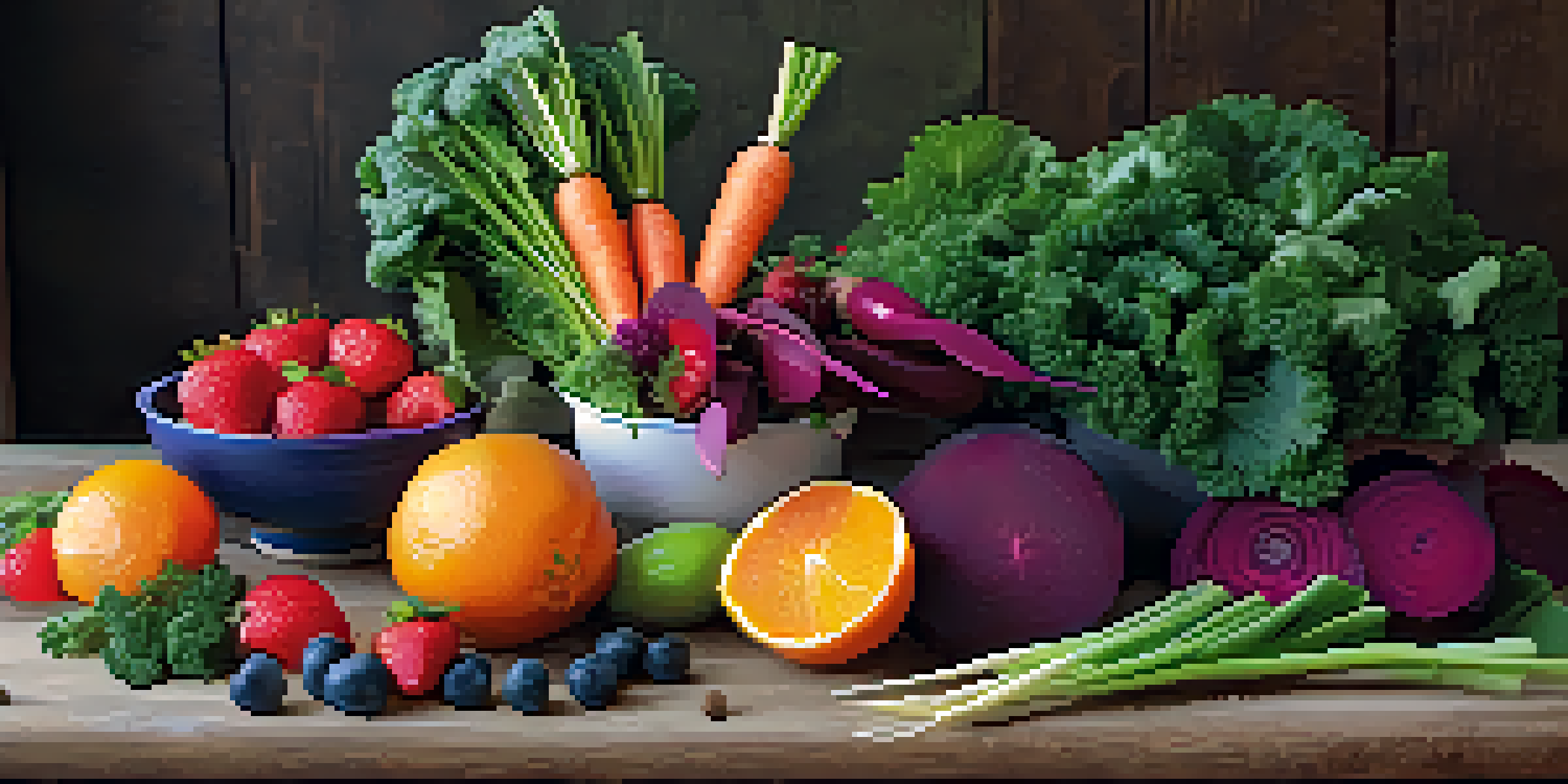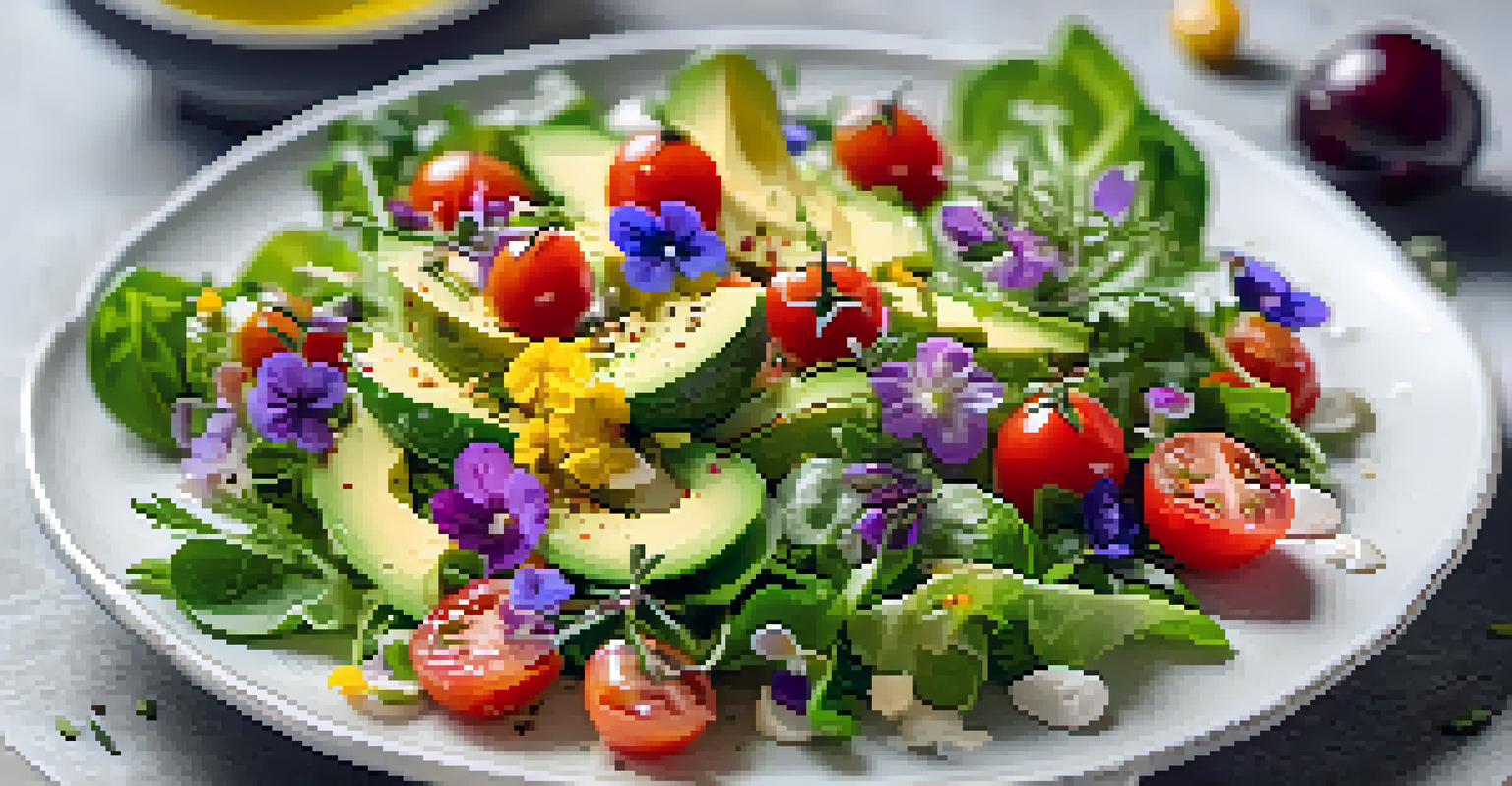Exploring Raw Food Diet's Role in Healthy Aging Processes

Understanding the Raw Food Diet and Its Basics
The raw food diet consists primarily of unprocessed, uncooked foods. This means fruits, vegetables, nuts, seeds, and sprouted grains take center stage. The idea is that cooking food can destroy vital nutrients and enzymes essential for health, making raw foods a powerhouse for nutrition.
Let food be thy medicine and medicine be thy food.
This diet is not just about eating salads; it encourages creativity in preparing meals through techniques like blending, juicing, and dehydrating. Raw food enthusiasts often highlight the vibrant flavors and textures that come from fresh ingredients. Think of it as a colorful art project on your plate, appealing to both the eyes and the taste buds.
Many people are drawn to the raw food diet for its potential health benefits, including weight loss, increased energy, and improved digestion. However, it’s important to balance raw foods with other food groups to ensure you’re getting all the nutrients your body needs for optimal aging.
Nutrients in Raw Foods That Support Healthy Aging
Raw foods are packed with essential vitamins, minerals, and antioxidants that play a crucial role in combating aging. For instance, vitamin C found in fresh fruits like oranges and strawberries helps protect skin health and boosts collagen production. This is vital for maintaining skin elasticity as we age.

Moreover, raw foods are rich in phytonutrients, compounds that provide anti-inflammatory benefits. These nutrients help reduce the risk of chronic diseases such as heart disease and diabetes, which become more common with age. Imagine these compounds as your body’s natural defense team, fighting off potential threats.
Raw Foods Boost Nutrient Intake
The raw food diet emphasizes unprocessed foods like fruits and vegetables, which are rich in essential nutrients that support overall health.
Fiber is another superstar in the raw food lineup. It aids digestion and helps maintain a healthy gut microbiome, which is linked to overall health. Consuming a variety of raw fruits and vegetables ensures you’re getting a diverse range of these critical nutrients, all of which contribute to a longer, healthier life.
The Connection Between Raw Foods and Longevity
Research suggests that diets high in plant-based foods can enhance longevity. A raw food diet, being predominantly plant-based, aligns well with this idea. Studies indicate that people who consume more fruits and vegetables tend to have lower mortality rates, suggesting a strong link between diet and lifespan.
The food you eat can be either the safest and most powerful form of medicine or the slowest form of poison.
Incorporating raw foods into your diet can also improve your overall quality of life as you age. With increased energy levels and better digestion, you may find yourself more active and engaged in activities you love. Think of it as fueling your body with high-quality fuel for your life’s journey.
Additionally, many raw food proponents report feeling a greater sense of well-being and mental clarity. This mental boost can be just as important as physical health when it comes to aging gracefully. When your mind is sharp and your body is nourished, you’re better equipped to enjoy every moment.
Potential Challenges of a Raw Food Diet
While the raw food diet offers numerous benefits, it also comes with challenges. For example, some people may find it difficult to meet their protein needs without cooking animal products or legumes. It’s crucial to explore plant-based protein sources like nuts, seeds, and sprouted grains to ensure you’re getting enough protein.
Another challenge is social situations where raw food options may be limited. Dining out or attending gatherings can become tricky when most dishes are cooked. Being proactive by bringing your own raw dishes or suggesting raw-friendly venues can help you stay on track while still enjoying social interactions.
Plant-Based Diet Enhances Longevity
Research suggests that a diet high in plant-based raw foods can lead to improved longevity and a lower risk of chronic diseases.
Lastly, some individuals may experience digestive discomfort when transitioning to a raw food diet. This is often due to the increased fiber intake. Gradually increasing your raw food intake can help your digestive system adjust, making the transition smoother and more sustainable.
Incorporating Raw Foods into Your Daily Life
Transitioning to a raw food diet doesn't have to be an all-or-nothing approach. Start by incorporating a few raw meals each week and gradually increase the amount. For instance, you could begin your day with a raw smoothie packed with fruits and leafy greens, setting a healthy tone for the day.
Experimenting with raw snacks is another great way to ease into this diet. Think of raw energy bars made with nuts and dates or fresh vegetable sticks with hummus. These snacks not only satisfy cravings but also provide a nutrient boost between meals.
Lastly, consider joining raw food communities or online groups. These platforms can offer support, recipe ideas, and motivation as you navigate your raw food journey. Sharing experiences with others can make the process more enjoyable and help you stay committed to your healthy aging goals.
The Role of Mindfulness in Eating Raw Foods
Mindfulness is an essential aspect of any healthy eating plan, including a raw food diet. Paying attention to your food choices and eating habits can enhance your relationship with food. This means savoring each bite and being conscious of how different foods make you feel.
Practicing mindfulness can also help you tune into your body’s hunger and satiety signals. This awareness can prevent overeating and promote healthier portion sizes, supporting weight management as you age. Picture it as a gentle conversation with your body, listening to what it needs.
Mindfulness Improves Eating Habits
Practicing mindfulness in food choices and preparation can enhance your relationship with food, promoting healthier eating habits.
Additionally, preparing raw meals can be a meditative experience. Chopping fresh vegetables, blending smoothies, or arranging a colorful salad can provide a calming ritual that enhances your overall well-being. Embracing this mindfulness can transform food preparation from a chore into a joyful practice.
Conclusion: Embracing Raw Foods for a Vibrant Future
Adopting a raw food diet can be a powerful step towards healthy aging. With its abundant nutrients and potential benefits for longevity, this lifestyle encourages vitality and well-being. Remember, every small change counts towards creating a healthier future.
While it may seem daunting at first, integrating raw foods into your diet can be a rewarding journey. Experimenting with flavors, textures, and recipes can make this transition enjoyable. It’s about finding what works for you and celebrating the delicious possibilities of raw eating.

Ultimately, embracing a raw food diet is not just about the food you eat; it’s about fostering a mindset of health and longevity. By prioritizing fresh, nourishing ingredients, you’re investing in a vibrant, energetic future that allows you to thrive as you age.